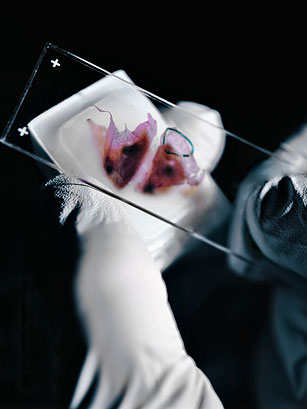
A scientist prepares to remove a small bit of tumor tissue — marked by the blue circle — from a biopsy sample for DNA sequencing
(2 of 3)
A New Look at an Old Idea
revolutionary as cancer genomics sounds, the goal of decoding a tumor's DNA isn't new. As far back as the 1960s, enterprising scientists identified an oddity in the size of one of the 23 pairs of chromosomes, the ropelike bundles in which DNA packages itself in cells. It is still known as the Philadelphia chromosome, a hallmark for identifying chronic myeloid leukemia. The problem with analyzing a tumor's DNA, however, has always been one of resolution. If the physical structure of a chromosome looks different in tumor cells, then there certainly must be changes in the genes packed inside. But how do you decipher the genetic instructions tucked so deeply away? How do you keep up with the uncanny power those genes give a cancer cell to sidestep drugs and find new ways to flourish?
The answer started to emerge in 2001 with the mapping of the human genome and its more than 30,000 genes. That biological blueprint serves as the key to answering all sorts of questions about the human condition — especially how normal development is supposed to proceed and where disease intrudes to alter that path.
Could the same be true of a tumor's genetic map? Could sequencing a cancer cell's genome expose its very operating system? Although Dr. Francis Collins, co-mapper of the human genome, was convinced that it could, it took until 2007, after refinement of the techniques and lowering of the cost associated with the process, for the National Institutes of Health to finally be able to begin sequencing cancer cells in a serious way. The mission of the Cancer Genome Atlas (TCGA) is to sequence dozens of cancers, with about 500 samples of each, by 2014. With "the Human Genome Project, the aim was to provide a catalog of the genes in the human genome. TCGA is building a catalog of the things that go wrong in cancer," says Paul Spellman of the National Cancer Institute.
Those things can range from an overactive gene to a complete swapping of DNA from one chromosome to another. "The cardinal feature of a cancer cell is that it's lost the identity it was born with," says Dr. Ernest Hawk, head of the division of cancer prevention and population sciences at MD Anderson Cancer Center in Houston. "It simply doesn't live a normal life and then die as normal cells do."
Researchers already had some limited experience in isolating and explaining the workings of cancer genes. The specific mutations linked to breast cancer in the BRCA 1 and BRCA 2 genes as well as alterations in a gene called APC, which normally suppresses tumor growth and is linked to colon cancer, are behind anywhere from 5% to a third of these diseases. But these are inherited aberrations, and cancers are triggered not only by the genes we get from our parents but also by corruptions to our genome that we acquire in our daily lives — from smoking, sun and diet as well as simple aging. "What has happened in cancer care over the past 20 years has been very piecemeal and ad hoc," says Dr. Todd Golub, director of the cancer program at the Broad Institute. "We discovered some cancer-causing genes here and there, often by stumbling across them. But the notion of being able to say that we are going to systematically and comprehensively interrogate the cancer genome has never been possible before."
Now, he says, improvements in the speed and precision of gene-sequencing technology are making broader sequencing of tumors more realistic. In 2001 the Human Genome Project produced one entire sequence of the human genome at a cost of $1 billion; today it's possible to map a cancer cell's genome for about $5,000, and it won't be long before that will dip to $1,000. In fact, it may soon cost more to store and analyze the data extracted from tumor genomes than it will to generate the maps.